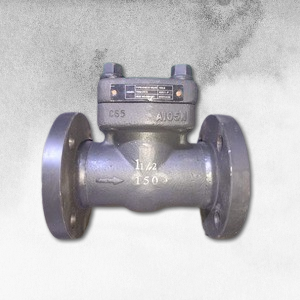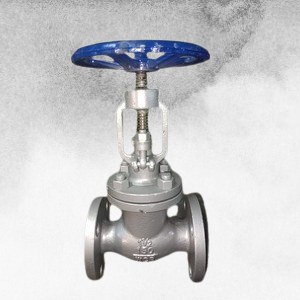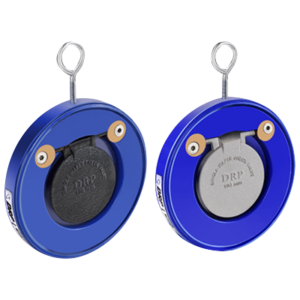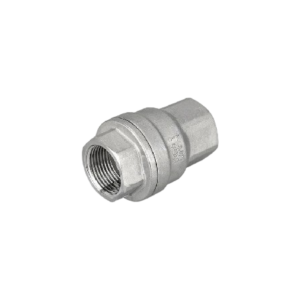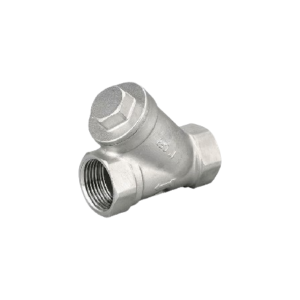CAST STEEL CHECK VALVES
Specifications:
- Material:
- Cast Steel (ASTM A216 WCB) is the most common material used for cast steel check valves. It offers good strength, toughness, and resistance to wear, making it ideal for use in high-pressure and high-temperature applications.
- Other materials such as ASTM A351 CF8M (stainless steel) or ASTM A217 WC9 (alloy steel) can be used depending on the specific requirements for corrosion resistance, temperature, and pressure.
- Pressure Rating:
- Available in pressure ratings such as Class 150, Class 300, Class 600, Class 900, and Class 1500 depending on the application and valve design.
- Common pressure classes: 150 PSI, 300 PSI, 600 PSI, and higher for extreme conditions.
- Size Range:
- Commonly available sizes range from 1/2″ to 24″ (15mm to 600mm), although custom sizes are available.
- Temperature Range:
- Typically, these valves are designed to operate within a temperature range of -29°C to +425°C (-20°F to +220°F), depending on the material used.
- Valve Type:
- Swing Check Valve or Lift Check Valve depending on the design.
- Swing check valves use a hinged disc that swings to allow flow in one direction and blocks reverse flow.
- Lift check valves have a disk or poppet that lifts off a seat to allow flow in one direction and returns to seat when flow stops or reverses.
- End Connections:
- Flanged (most common), Threaded, or Butt Weld connections.
- Seal Type:
- Seals can be made from rubber, PTFE, or metal-to-metal depending on the material and application requirements.
Classification:
- Type: Check Valve (Cast Steel)
- Application: Used to allow flow in one direction and prevent backflow in pipelines. Essential in many industries, including oil & gas, water treatment, petrochemical, and power generation.
- Materials: WCB (ASTM A216), CF8M (Stainless Steel), WC9 (Alloy Steel), depending on application.
- Pressure Rating: Class 150, Class 300, Class 600, Class 900, or Class 1500, depending on the application.
- Valve Type: Swing or Lift Check Valve.
Description:
The Cast Steel Check Valve is an automatic valve used in pipelines to allow flow in only one direction and to prevent backflow. Its primary function is to protect equipment such as pumps, compressors, and turbines from damage caused by reverse flow, which can lead to mechanical failure, contamination, and system inefficiency.
Made from cast steel (commonly ASTM A216 WCB), this valve is built to withstand high pressure, temperature, and the physical demands of various applications. The valve’s design typically features a hinged disc or a poppet, which is pressed against the valve seat by the fluid flow. When the flow direction is reversed, the disc or poppet moves to seal off the flow path, preventing backflow.
Swing Check Valves are ideal for low-pressure applications and are used in systems with fluid or gas flow where a simple design is sufficient to prevent backflow. The hinged disc swings open and closed based on the fluid flow direction.
Lift Check Valves operate by allowing the disc or poppet to move vertically off its seat when the flow pressure is sufficient, and automatically closing when the flow reverses, creating a secure seal.
Cast Steel Check Valves are commonly used in a variety of industries, including:
- Oil & Gas: For pipeline systems to prevent backflow that could damage pumps and compressors.
- Water Treatment: To protect equipment and ensure a steady flow of treated water.
- Petrochemical: In chemical production systems, where backflow could cause contamination.
- Power Generation: To ensure that steam and other fluids flow in one direction in boilers, turbines, and heat exchangers.
- Industrial Systems: For safeguarding pumps, valves, and other machinery.
Advantages:
- Durability: Cast steel offers strong resistance to wear, corrosion, and high pressure.
- Leak-Proof: Ensures secure sealing and protection against backflow.
- Automatic Operation: Requires no manual operation or external control; the valve works automatically based on the flow direction.
- Versatile: Suitable for a wide range of applications, including high-temperature and high-pressure systems.
Applications:
- Pipeline Protection: Prevents backflow, safeguarding pumps, compressors, and other equipment.
- Pressure Control: Used in systems where pressure relief is critical, and backflow could cause significant issues.
- Industrial Systems: Employed in chemical processing, food processing, and other industries to control fluid and gas flow direction.
